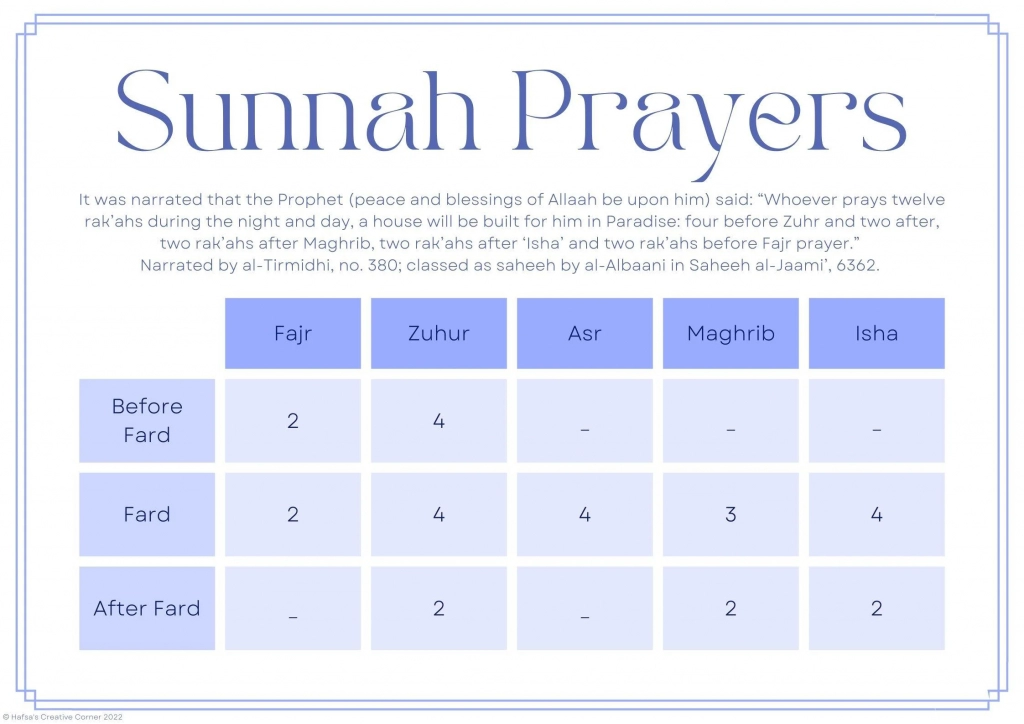Isha is a name given to the beginning of darkness from sunset to darkness, and the Isha prayer is called by that name; Because it is performed at that time. it is also called the darkness prayer. Al-Bukhari included in his Sahih on the authority of Abu Hurairah – may God be pleased with him – that the Prophet – upon him be blessings and peace – said: If they knew what is in the darkness and the morning, they would have come to them even if they crawled. Narrated by Al-Bukhari.
What is Isha Prayer?
Isha prayer is the final prayer of the day in Islam, and it is offered after the Maghrib prayer. It is the fifth obligatory prayer that Muslims offer every day. The time for Isha prayer starts after the disappearance of the twilight and ends before midnight. The Isha prayer consists of four rakats or units of prayer, and it is considered one of the most important prayers in Islam.
Significance of Isha Prayer
Isha prayer holds great significance in Islam. It is believed that offering Isha prayer helps in seeking forgiveness from Allah, purifying the soul, and getting closer to Allah. It is also believed that offering Isha prayer regularly helps in erasing sins and gaining rewards in the hereafter. Furthermore, the Prophet Muhammad (PBUH) emphasized the importance of Isha prayer and encouraged Muslims to offer it regularly.
The Procedure of Isha Prayer

The procedure of offering Isha prayer is as follows:
- Make sure you have performed the ablution (Wudu) before starting the prayer.
- Stand facing the Qiblah, which is the direction of the Kaaba in Mecca, and make the intention (Niyyah) to offer the Isha prayer.
- Raise your hands to your ears and say the Takbir (Allahu Akbar), which means “Allah is the Greatest.”
- Recite Surah Al-Fatihah, which is the first chapter of the Quran, and then recite another chapter or portion of the Quran.
- Bow down and say “Subhana Rabbiyal Azeem” (Glory be to my Lord, the Greatest) three times.
- Stand up straight and say “Sami Allahu liman hamidah” (Allah hears those who praise Him) and then say “Rabbana lakal hamd” (Our Lord, praise be to You).
- Prostrate and say “Subhana Rabbiyal A’la” (Glory be to my Lord, the Highest) three times.
- Sit up straight and say “Allahu Akbar” and then prostrate again and repeat the same phrase.
- Sit up straight again and recite the Tashahhud, which is a declaration of faith in Allah and His Prophet Muhammad (PBUH).
- End the prayer by turning your head to the right and saying “Assalamu Alaikum wa Rahmatullah” (Peace be upon you and the mercy of Allah) and then turn your head to the left and repeat the same phrase.
Tips for Offering Isha Prayer
Here are some tips for offering Isha prayer:
- Make sure you offer Isha prayer on time and don’t delay it.
- Choose a quiet and clean place to offer Isha prayer.
- Focus on the prayer and avoid any distractions.
- Recite the Quran slowly and with proper pronunciation.
- Try to pray with sincerity and humility.
Benefits of Performing Isha Prayer
Performing Isha prayer regularly has numerous benefits, including both spiritual and physical benefits. Here are some of the benefits of performing Isha prayer:
- Getting closer to Allah: Offering Isha prayer regularly helps in getting closer to Allah and seeking His forgiveness.
- Purifying the soul: Isha prayer helps in purifying the soul and getting rid of negative emotions like anger, jealousy, and greed.
- Erasing sins: Regularly offering Isha prayer helps in erasing sins and gaining rewards in the hereafter.
- Strengthening faith: Performing Isha prayer regularly strengthens one’s faith and belief in Allah.
- Better sleep: Performing Isha prayer before going to bed helps in calming the mind and getting better sleep.
- Reducing stress: Prayer, in general, has been shown to reduce stress levels, and performing Isha prayer can have the same effect.
- Strengthening muscles: The act of standing, bowing, and prostrating during Isha prayer can help in strengthening the muscles and improving overall physical health.
The Sunnah Actions of Isha Prayer

In addition to the obligatory actions of Isha prayer, there are also some recommended (Sunnah) actions that one can perform. Here are some of the Sunnah actions of Isha prayer:
- Reciting Surah Al-Kafirun in the first rakat and Surah Al-Ikhlas in the second rakat.
- Reciting the Du’a Qunoot, which is a supplication recited during the last rakat of Isha prayer.
- Reciting the Tasbeeh, which is a glorification of Allah, after the final Tashahhud.
- Making a supplication (Du’a) after the final Taslim.
The Confirmed Sunnah of Isha Prayer
The confirmed Sunnah number of rak’ahs for the evening prayer is two rak’ahs after it. Abdullah Ibn Omar – may God be pleased with him – said: I memorized ten rak’ahs from the Prophet, may God bless him and grant him peace, two rak’ahs before noon, and two rak’ahs after it, Two rak’ahs after sunset in his house, two rak’ahs after dinner at his house, and two rak’ahs before the morning prayer.
And there was an hour during which he did not enter upon the Prophet, may God bless him and grant him peace. Hafsa told me: When the muezzin called the call to prayer and dawn came, he would pray two rak’ahs.) Narrated by Al-Bukhari.
The Prophet – upon him be peace and blessings – was praying it at home, due to the hadith of Aisha – may God be pleased with her – that the Prophet used to lead the people in prayer for dinner, and he would enter my house and pray two rak’ahs. Narrated by Muslim.
Unconfirmed Sunnahs for Isha
They are the two rak’ahs that are prayed between the call to prayer and the iqama and before the obligatory prayer, due to the hadith of the Prophet – upon him be blessings and peace: (There is no obligatory prayer except that there are two rak’ahs in front of it). Narrated by Albani.
Common Mistakes to Avoid during Isha Prayer
Here are some common mistakes that Muslims should avoid during Isha prayer:
- Not performing the prayer on time.
- Not performing the ablution (Wudu) before the prayer.
- Not facing the Qiblah during the prayer.
- Rushing through the prayer and not reciting the Quran properly.
- Not focusing on the prayer and getting distracted by other things.
How to Make Up a Missed Isha Prayer
If someone misses the Isha prayer, they can make it up later. Here’s how to make up a missed Isha prayer:
- Make the intention to make up the missed prayer.
- Perform the ablution (Wudu).
- Offer the missed Isha prayer, following the same procedure as described above.
The Recommended Azkar after Isha Prayer
After performing Isha prayer, Muslims are encouraged to recite some Azkar, which are supplications and phrases of remembrance. Here is some recommended Azkar after Isha prayer:
- Reciting Ayat Al-Kursi, which is a verse from the Quran that talks about the greatness of Allah.
- Reciting Surah Al-Ikhlas, which is a short chapter of the Quran that emphasizes the Oneness of Allah.
- Seeking forgiveness from Allah by reciting Astaghfirullah (I seek forgiveness from Allah).
How Do You Perform 3 Rakat Witr in Isha?
The Witr prayer is like other prayers, but it differs from the rest of the prayers in that it is individual. So he prays one rak’ah, or three, or five, or seven, or eleven, or thirteen rak’ahs.
The majority of jurists believe that the Witr prayer is performed two by two; That is, two rak’ahs, two rak’ahs, and after each two rak’ahs the worshiper gives peace, then comes with a single rak’ah and gives the peace after it. This is the general structure of the Witr prayer. For example, if a Muslim is going to pray three rak’ahs, then he prays two rak’ahs and gives the salutation, then prays one single rak’ah.
Here are the opinions of the jurists on how to perform the Witr prayer:
That he prays three rak’ahs, separating them in peace after the two rak’ahs of the preemptive, then brings one in which he testifies and gives peace, and the jurists have agreed on this form, with the exception of the Hanafis.
To pray three rak’ahs with one salutation and one tashahhud, and this form is the only one for the Hanafi community.
Conclusion
In conclusion, Isha prayer is an important and essential aspect of the Islamic faith. It helps in seeking forgiveness from Allah, purifying the soul, and getting closer to Allah. Muslims should make an effort to perform Isha prayer regularly and follow the correct procedure. They should also be aware of the Sunnah actions, common mistakes to avoid, and the recommended Azkar after the prayer. By following these guidelines, Muslims can benefit spiritually and physically from performing Isha prayer.
Isha Prayer FAQs
Can I pray Isha after midnight?
No, because the time for Isha prayer ends at midnight. The Prophet, peace be upon him, said: The time for Isha ends at midnight. The reckoning of the night begins from sunset by the hour.
Can I combine Isha prayer with another prayer?
Yes, Isha prayer can be combined with Maghrib prayer if there is a valid reason such as traveling or illness. However, it is not recommended to do so regularly.
Can I perform Isha prayer in congregation?
Yes, it is recommended to perform Isha prayer in congregation, especially for men.
What if I miss the Isha prayer due to circumstances beyond my control?
If you miss the Isha prayer due to circumstances beyond your control, such as being in a coma or under anesthesia, then you are not held accountable. However, if you miss the prayer intentionally or due to negligence, then you should make it up as soon as possible.
Can I perform Isha prayer while sitting?
Yes, if you are unable to stand due to illness or disability, you can perform Isha prayer while sitting or even lying down.
Can I perform Isha prayer without performing the Sunnah actions?
Yes, you can perform Isha prayer without performing the Sunnah actions, but it is recommended to perform them as they have numerous benefits.

